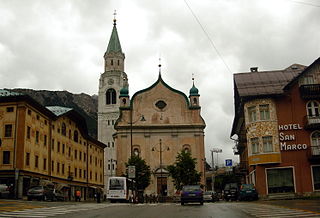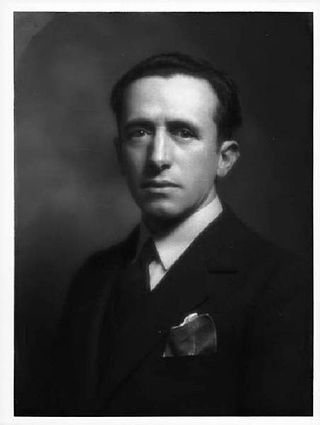
Cortina d'Ampezzo is a town and comune in the heart of the southern (Dolomitic) Alps in the Province of Belluno, in the Veneto region of Northern Italy. Situated on the Boite river, in an alpine valley, it is a summer and winter sport resort known for its skiing trails, scenery, accommodation, shops and après-ski scene, and for its jet set and Italian aristocratic crowd.

San Biagio di Callalta is a comune (municipality) in the province of Treviso, Veneto, north-eastern Italy.

The Dolomites Railway, originally the Ampezzaner Bahn or Ampezzaner Railway, was a railway in Northern Italy crossing the Dolomites mountains. The 64.9-kilometre (40.3-mile) long railway began in Calalzo and ended in Toblach. Its gauge was 950 mm — "Italian metre gauge". The Cortina d'Ampezzo - Toblach part was closed in 1962 and the Cortina d'Ampezzo - Calalzo di Cadore in 1964. Two EMUs went to the Trento - Malè railway and are still in use. Other vehicles went to the Ferrovie Appulo Lucane.

The Eugenio Monti olympic track is a bobsleigh and skeleton track located in Cortina d'Ampezzo, Italy. It is named after Eugenio Monti (1928–2003), who won six bobsleigh medals at the Winter Olympic Games between 1956 and 1968 and ten medals at the FIBT World Championships between 1957 and 1966. It was featured in the 1981 James Bond film For Your Eyes Only, held after the 1981 FIBT World Championships, before the track was shortened to its current configuration. In January 2008, after a last bobsleigh race tournament, the track was closed.
Giuseppe Fabre was an Italian Generale di Corpo d'Armata and skier.

The Asiago War Memorial is a World War I memorial located in the town of Asiago in the Province of Vicenza in the Veneto region of northeast Italy. Surrounded by mountains that were the site of several World War I battles, the monument houses the remains of over 50,000 Italian and Austro-Hungarian soldiers and is a popular destination for travelers to the region. In Italian the memorial is typically called Sacrario Militare di Asiago or Sacrario Militare del Leiten. Leiten is the name of the hill on which the memorial sits.

Tre Sassi fort is a fortress and museum on the road to the Passo di Valparola, within the comune of Cortina d'Ampezzo in the southern (Dolomitic) Alps of the Veneto region of Northern Italy. Hidden between the Ampezzo valley and the high Val Badia, it was built by Austrians between 1897 and 1901 as a fortification against attack from the Italians on the Falzàrego and Valparo. During World War I it was a favorite target for the Italians, and the fort was destroyed as there was inadequate artillery to defend it.

Castello di Botestagno is a ruined medieval fort in the comune of Cortina d'Ampezzo in the southern (Dolomitic) Alps of the Veneto region of Northern Italy. It is perched on a rock in the valley of the Boite River, a little further north of Cortina, in the town of Prà del Caštel.

Antonio Cantore was an Italian general.

Basilica Minore dei Santi Filippo e Giacomo is a Catholic basilica located in Cortina d'Ampezzo, Italy. It is dedicated to the Apostles Philip and James, patron saint of Cortina d'Ampezzo. It is the home of the parish and the deanery of Cortina d'Ampezzo. Built between 1769 and 1775 in the Baroque style to a design by the architect Joseph Promperg, it sits on the site where two previous churches had existed from the 13th and 16th centuries.

Mario Rimoldi Modern Art Museum is a contemporary and modern art museum in Cortina d'Ampezzo, Italy. It is one of three museums administered by Le Regole d'Ampezzo, the other two being the Rinaldo Zardini Palaeontology Museum and the Regole of Ampezzo Ethnographic Museum. It opened in 1974 after a donation from Rosa Braun, the widow of Mario Rimoldi. Rimoldi's collection was displayed in 1941, it moved to the Regole d'Ampezzo in 1963, and by 1995, the collection contained 364 works of art. The collection is said to contain some of the most influential Italian art produced between World War I and World War II, and provides a perspective of the modern art movement in Veneto, Italy pre-1940.The museum's permanent exhibition includes works by Filippo De Pisis, Felice Carena, Pio Semeghini, Renato Guttuso, Tullio Garbari, and Massimo Campigli. The museum is also used as a venue for live music performances.

Cappella della Beata Vergine di Lourdes is a Roman Catholic chapel located in Cortina d'Ampezzo's Grava di Sotto neighborhood. Built in 1907, it contains elements by the artist Corrado Pitscheider of the Val Gardena. Its feast day is celebrated on 11 February. The interior features a spacious nave, an altar, and the Lourdes grotto. The space is lit by large windows. There are statues of the Virgin and Santa Bernadette, as well as St. Lucia and St. Michael the Archangel. A framed canvas of St. Joseph with the Child hangs in the presbytery.

The Sacrario dei Caduti Oltremare is a World War II memorial located in the city of Bari, in the Apulia region of Southern Italy. The shrine, inaugurated in 1967, houses the remains of 75,098 Italian soldiers killed overseas in both World Wars as well as in Italy's colonial wars.

The Redipuglia War Memorial is a World War I memorial located on the Karst Plateau near the village of Fogliano Redipuglia, in the Friuli Venezia Giulia region of northeastern Italy. It is the largest war memorial in Italy and one of the largest in the world, housing the remains of 100,187 Italian soldiers killed between 1915 and 1917 in the eleven battles fought on the Karst and Isonzo front.

The Italian Charnel House, Kobarid, is an Italian military shrine in Kobarid, Slovenia. Sited on the battlefield of Caporetto, it houses the remains of 7,014 Italians who fell during the battles of the Isonzo.

The military memorial of Monte Grappa is the largest Italian military ossuary of the First World War. It is located on the summit of Monte Grappa between the provinces of Treviso and Vicenza, at 1,776 meters above sea level. Access to the memorial is via the Strada Cadorna, built by the army on the orders of General Luigi Cadorna to bring construction materials for the fortification on Monte Grappa in 1917.

The Oslavia War Memorial is an Italian monument to soldiers who fell in battle during the battles of the Isonzo, particularly those who died during the taking of Gorizia in 1916. It stands on a 150m hill in the village of Oslavia, on the outskirts of Gorizia. The hilltop was on the front line as Austro-Hungarian troops defended the salient around Gorizia during the first, third and fourth battles of the Isonzo.
Italy national bobsleigh team is the selection that represents Italy in international bobsleigh competitions.

Giovanni Greppi was an Italian architect best known for having designed some of the most famous military shrines in Italy.

Olimpia delle Tofane is the classic women's World Cup downhill ski course in Cortina d'Ampezzo, Italy. It debuted 67 years ago at the 1956 Winter Olympics, hosting the men's downhill.


















